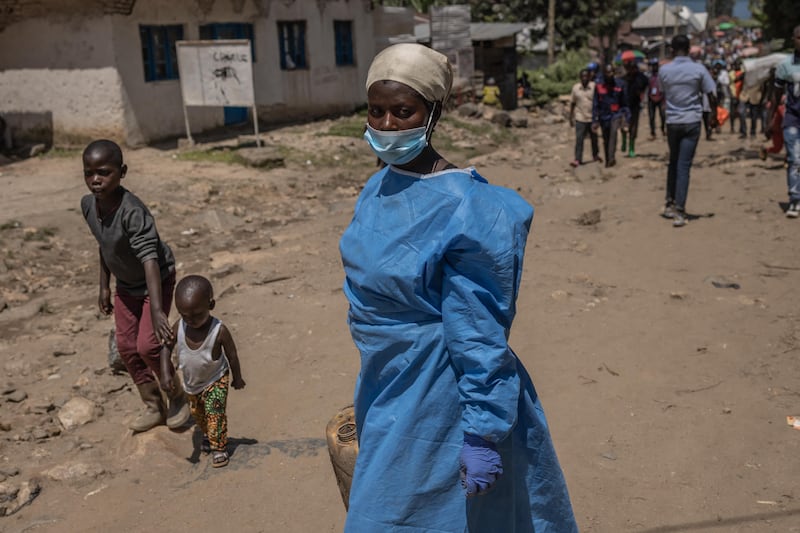At least 411 people are now known to have died in intense flooding and landslides that hit the Democratic Republic of the Congo’s South Kivu province last week.
Efforts to rescue inhabitants and recover bodies in Kalehe, where the flooding happened, are continuing. Some houses, schools and hospitals have collapsed or become dilapidated or unsafe. Others were entirely swept away.
“There are some places that had houses, but you look at them now and can’t imagine that there was anything there before,” said Ulrich Crepin Namfeibona, the Médecins Sans Frontières (MSF) emergency co-ordinator in South Kivu.
The torrential rains wiped out entire villages, along with fields of crops and livestock, leaving communities reeling. About 5,500 people are still missing, and thousands of survivors have been left homeless, according to MSF.
How a hotter world is affecting Ireland in five graphics
Death toll in Spain’s floods rises to 158 with ‘dozens and dozens’ missing, says minister
Spain floods: How could so much rain fall in such a short space of time in Valencia?
Disaster Nationalism by Richard Seymour: A passionate call for an urgent change of course
Residents of Bushushu and Nyamukubi villages, hardest hit by the disaster, have had to travel long distances on foot to evacuate to neighbouring villages – some as far as a three-hour walk away. Even motorbikes cannot navigate the area’s severely damaged pathways.
“Some of them have relatives in the other villages, but some go there without knowing anyone,” said Mr Namfeibona.
The infrastructure in Kalehe is poor, which can make communication and access difficult when such disasters occur. About 150 people were wounded and needed medical attention.
“My biggest concern is healthcare for the injured patients,” said Mr Namfeibona. “More than 30 needed emergency surgery yesterday that the hospitals around do not have the [technical] capacity for.”
One of the main roads out of Kalehe has been rendered impassable, hampering aid and rescue efforts. Medical teams have had to first take wounded people to a local hospital where they are triaged and wait, often for hours, until they are ferried out of the area by boat via Lake Kivu to a hospital in Bukavu town, which is a nearly three-hour boat ride away.
Many of the dead have been buried in mass graves, prompting pushback from some community leaders and an order by government officials for coffins to be delivered to the area.
Kalehe, a remote rural area in eastern DRC, has a high population of displaced people – many of whom rely on logging and charcoal production for a living. The area has historically attracted higher levels of rainfall due to its proximity to forests, but higher deforestation rates, coupled with slash-and-burn agriculture and the clearing of land for homes, means the mountainous region is particularly vulnerable to landslides during heavy rains.

“The environment is completely ruined. Rains don’t come when we expect, and when they do, it sweeps everything,” said Josué Aruna, head of an environmental civil society network in South Kivu, adding that the land needed massive restoration. “If no mitigation plans are taken, climate change will continue to bring an even bigger disaster than we are seeing now.”
The DRC floods happened days after deadly flooding in Rwanda, on the other side of Lake Kivu, which killed roughly 130 people. Uganda also experienced flooding, which caused 18 deaths and left thousands displaced. Predictions by the World Bank suggest about 86 million Africans will migrate within their own countries by 2050 as a result of the climate crisis.
Extreme weather events are occurring with increased frequency in the region, from a severe drought in the eastern Horn of Africa to excessive rainfall in other parts of east and central Africa.
“Climate change is a story of extremes,” said Nazanine Moshiri, a climate, environment and conflict analyst for Africa at the International Crisis Group. “Seasonal flooding is typical in this region, but nothing like these floods has occurred in recent years,” she added, saying that the climate disasters were placing huge pressure on affected communities, driving internal displacement and overwhelming local coping mechanisms.
The UN secretary general, António Guterres, called the DRC flooding “yet another illustration” of the climate crisis’s “disastrous impact on countries that have done nothing to contribute to global warming”.
Climate activists and community leaders say that despite recurring extreme weather events, preparation and adaptation has not yet been properly prioritised by the DRC government, amid competing priorities.
Yoba Alenga, a climate activist from South Kivu, said people were often left to their own devices when it came to rebuilding after the floods. “It will be challenging for them. Many people here don’t have an option but to return home eventually, and start over again.” - Guardian




